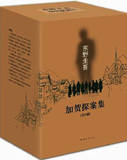
 |
登入帳戶
| 訂單查詢
| |
||
| 會員登入 新用戶登記 | |||
| 臺灣用戶 |
| 品種:超過100萬種各類書籍/音像和精品,正品正價,放心網購,悭钱省心 | 服務:香港/台灣/澳門/海外 | 送貨:速遞/郵局/服務站 |
|
| 大陸出版:中信出版社,南海出版社,譯林出版社,作家出版社,人民郵電出版社,機械工業出版社,電子工業出版社,化學工業出版社,人民出版社,社會科學文獻出版社,人民文學出版社,商務印書館,三聯書店,北京大學出版社,清華大學出版社,中國人民大學出版社,外語教學與研究出版社,高等教育出版社,北京師範大學出版社,北京理工大學出版社,中國輕工業出版社,中國建築工業出版社,北京聯合出版,北京十月文藝出版社,國際文化出版公司,二十壹世紀出版社,人民美術出版社,上海人民美術出版社,四川美術出版社,天津人民美術出版社,遼寧美術出版社,吉林美術出版社,黑龍江美術出版社,連環畫出版社,北京工藝美術出版社,美術類出版,中國戲劇出版社,嶽麓書社,广陵书社,群言出版社,地震出版社,中國地圖出版社,中國文史出版社,中央編譯出版社,上海古籍出版社,上海辭書出版社,中國大百科全書出版社,吉林出版集團,世界知識出版社,世界圖書出版公司,法律出版社,人民衛生出版社,人民軍醫出版社,中國中醫藥出版社,中國鐵道出版社,中國電力出版社,科學出版社,中國少年兒童出版社,廣西師範大學出版社,陜西師範大學出版社,江蘇科學技術出版社,江蘇文藝出版社,安徽文藝出版社,長江文藝出版社,經濟日報出版社,光明日報出版社,線裝書局,萬卷出版公司,新星出版社,新蕾出版社,接力出版社,青島出版社,浙江人民出版社,新世界出版社,新經典文化,中華工商聯合出版社,中國商業出版社,廣東旅遊出版社,廣東經濟出版社,同心出版社,海燕出版社,華語教學出版社,宗教文化出版社
港台出版:尖端出版,皇冠文化,時報文化,臺灣商務印書館,三民書局,天下文化,天下雜誌,商周出版,三采,東立,木馬文化,楊桃文化,柿子文化,大邑文化,上奇資訊,佳魁資訊,碁峰,新學林,小熊出版,方舟文化,曼尼文化,馬可孛羅,零極限,風和文創,邦聯文化,知翎文化,人類文化,好優文化,華成圖書,正文社,朵琳,大樂文化,小魯文化,大喜文化,眾文,原水,采實文化,核果文化,博碩,新銳文創,台灣東販,紙印良品,先覺,漫遊者文化,經濟新潮社,麥浩斯,柿藤出版社,大境,臉譜,旗標,瑞華文化,樂幼文化,果禾文化,雅書堂,博識圖書,瑞昇,晨星,悅知文化,瑞蘭國際,水滴文化,藝風堂,尚昂文化,高寶,文經閣出版社,讀品文化,普天出版社,大是文化,無限出版,布拉格文創社,活字文化,遠足文化,致良,圓神,蓋亞,大田,楓書坊,麥田出版,遠流出版公司,藝文印書館,聯經出版,九章出版社,大然文化,春天出版,城邦文化,青文出版社,爾雅出版社,新學友書局,楓樹林出版社,南一書局,五南文化,基本書坊,時兆出版社,獨步文化,有意思,空中英语教室,群學出版有限公司,麗文文化事業機構,奇幻基地 |
 東野圭吾 精品集 |
 加賀探案集 套裝9冊 |
 疾風迴旋曲 |
 禁忌魔術 |
 虛像小丑 |
 秘密 |
 幻夜 |
 放學後 |
 夏天,十九歲的肖像 |
 寫樂 閉鎖之國的幻影 |
 後巷說百物語 |
 離別的火焰 |
 手掌上的黑暗 |
 朋克刑警的驕傲 |
 Level 7 |
 羅生門 |
 中国大百科全书 |
 不列颠百科全书 |
 中国通史 |
 世界通史 |
 二十四史 |
 全球通史 |
 资治通鉴 |
 辞海 |
 紅樓夢 |
 西游记 |
 孔子三语集 |
 聊斋志异 |
 十一家注孙子 |
 十三经注疏 |
 中华传世家训经典 |
 民国秘史 |
 现代世界体系 |
 群书治要 |
 南怀瑾选集 |
 陈寅恪集 |
 鲁迅全集 |
 周恩来传 |
 古文观止 |
 诗经·尚书 |
 中国天文年历 |
 金融不良资产市场调查报告 |
 国际金融中心发展报告 |
 港澳气候变化评估报告 |
 中国投资发展报告 |
 中国文化文物和旅游统计年鉴 |
 工智能:现代方法 |
 面向计算机科学家的量子计算 |
 预测心智 |
 一本书读懂边缘计算 |
 硬科技2:从实验室到市场 |
 高效算力筑基数字社会 |
| 書城介紹 | 合作申請 | 索要書目 | 新手入門 | 聯絡方式 | 幫助中心 | 找書說明 | 送貨方式 | 付款方式 | 香港用户 | 台灣用户 | 海外用户 |
| megBook.com.hk | |
| Copyright © 2013 - 2025 (香港)大書城有限公司 All Rights Reserved. | |